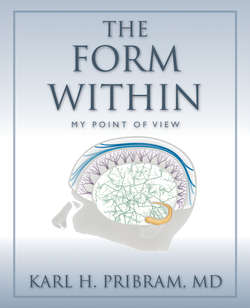Читать книгу The Form Within - Karl H Pribram - Страница 15
На сайте Литреса книга снята с продажи.
The Intrinsic Cortex of the Brain
ОглавлениеThe only way to resolve whether cognitive difficul-ties could arise from damage that is restricted to the silent cortex was to work with animals, work enabling me to control the extent of removal and test the animals over a period of years. The similarity of the monkey brain to the human made the monkey an ideal choice for this research.
Monkeys have an added advantage: once a part of their brain has been removed, the rest of the brain becomes reorganized and reaches a stable condition after a few months. The monkeys can then be tested daily for years in that stable condition, allowing us to pursue a full exploration of the condition the monkey and his brain are now in. The animals are precious and we treat them as we would treat any treasured creature.
The results of my initial program were immediately successful. With my collaborators, I was able to show that parts of the silent cortex are indeed responsible for organizing sensory-specific cognitive functions, without any involvement of adjacent primary sensory systems. Monkeys have a sufficient reach of cortex that lies between the sensory receiving regions to allow careful removal without inadvertent damage to these regions or the tracts reaching them from sensory receptors. My experimental results showed that indeed sensory-specific deficiencies were produced by resections of cortex that had no direct connections with sensory receptors or motor controls. I labeled these parts of the cortex “intrinsic” (following a nomenclature introduced for the thalamus) by Jersey Rose, professor at the Johns Hopkins University and “extrinsic” (those parts of the cortex that had “direct” connections with receptors and effectors). It is now generally accepted that processing in parts of the “intrinsic” cortex is sensory specific, while in other parts a variety of inter-sensory and sensory-motor processes are organized.
My success was due to my bringing to bear neurosurgical techniques that I had learned to apply in humans, techniques that allowed me to gently make extensive removals of cortex without inadvertent damage to underlying and adjacent tissue. I obtained dramatic changes in behavior: the monkeys were markedly impaired when they had to make choices despite their unimpaired performances on tests of perception. I then restricted the extent of removal and demonstrated that the impairment of choices is not a “global cognitive” difficulty but is related to one or another sense modality. Today, these more restricted regions are commonly known as making up the “sensory-specific association cortex” (an oxymoron).
A brilliantly conceived study performed on humans at the Weizmann Institute in Israel has supported the conclusions I obtained with monkeys. Subjects were shown a variety of videos and fMRIs were recorded while they were watching. No response was asked for. Rafael Malach concludes:
Examining fMRI activations under conditions where no report or introspective evaluation is requested— such as during an engaging movie—reveals a surprisingly limited activation . . . the very same networks which are most likely to carry high order self-related processes appear to shut off during intense sensory-motor perception.
Local networks in the posterior visual cortex were the only ones activated by a visual percept. Simple visual stimulation engaged the extrinsic occipital region; greater involvement, as in viewing movies, engages the intrinsic visual systems of the temporal lobe. (Malach, in his presentation, used the terms “extrinsic” and “intrinsic,” which I had used decades earlier.) A fronto-parietal spread of activation occurs with self-related processing such as motor planning, attentional modulation and introspection.
